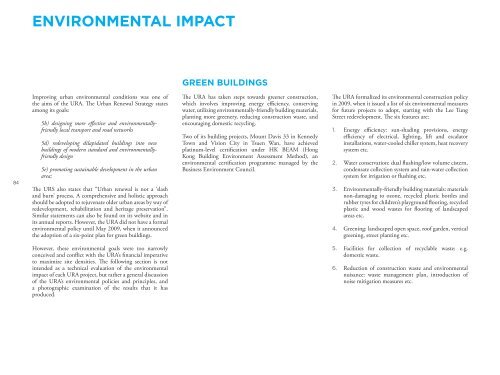Treating the Symptoms - A Critical Review of ... - Civic Exchange
Treating the Symptoms - A Critical Review of ... - Civic Exchange
Treating the Symptoms - A Critical Review of ... - Civic Exchange
- No tags were found...
You also want an ePaper? Increase the reach of your titles
YUMPU automatically turns print PDFs into web optimized ePapers that Google loves.
Environmental ImpactGreen Buildings84Improving urban environmental conditions was one <strong>of</strong><strong>the</strong> aims <strong>of</strong> <strong>the</strong> URA. The Urban Renewal Strategy statesamong its goals:5b) designing more effective and environmentallyfriendlylocal transport and road networks5d) redeveloping dilapidated buildings into newbuildings <strong>of</strong> modern standard and environmentallyfriendlydesign5e) promoting sustainable development in <strong>the</strong> urbanarea;The URS also states that “Urban renewal is not a ‘slashand burn’ process. A comprehensive and holistic approachshould be adopted to rejuvenate older urban areas by way <strong>of</strong>redevelopment, rehabilitation and heritage preservation”.Similar statements can also be found on its website and inits annual reports. However, <strong>the</strong> URA did not have a formalenvironmental policy until May 2009, when it announced<strong>the</strong> adoption <strong>of</strong> a six-point plan for green buildings.The URA has taken steps towards greener construction,which involves improving energy efficiency, conservingwater, utilizing environmentally-friendly building materials,planting more greenery, reducing construction waste, andencouraging domestic recycling.Two <strong>of</strong> its building projects, Mount Davis 33 in KennedyTown and Vision City in Tsuen Wan, have achievedplatinum-level certification under HK BEAM (HongKong Building Environment Assessment Method), anenvironmental certification programme managed by <strong>the</strong>Business Environment Council.The URA formalized its environmental construction policyin 2009, when it issued a list <strong>of</strong> six environmental measuresfor future projects to adopt, starting with <strong>the</strong> Lee TungStreet redevelopment. The six features are:1.2.3.4.Energy efficiency: sun-shading provisions, energyefficiency <strong>of</strong> electrical, lighting, lift and escalatorinstallations, water-cooled chiller system, heat recoverysystem etc.Water conservation: dual flushing/low volume cistern,condensate collection system and rain-water collectionsystem for irrigation or flushing etc.Environmentally-friendly building materials: materialsnon-damaging to ozone, recycled plastic bottles andrubber tyres for children’s playground flooring, recycledplastic and wood wastes for flooring <strong>of</strong> landscapedareas etc.Greening: landscaped open space, ro<strong>of</strong> garden, verticalgreening, street planting etc.However, <strong>the</strong>se environmental goals were too narrowlyconceived and conflict with <strong>the</strong> URA’s financial imperativeto maximize site densities. The following section is notintended as a technical evaluation <strong>of</strong> <strong>the</strong> environmentalimpact <strong>of</strong> each URA project, but ra<strong>the</strong>r a general discussion<strong>of</strong> <strong>the</strong> URA’s environmental policies and principles, anda photographic examination <strong>of</strong> <strong>the</strong> results that it hasproduced.5.6.Facilities for collection <strong>of</strong> recyclable waste: e.g.domestic waste.Reduction <strong>of</strong> construction waste and environmentalnuisance: waste management plan, introduction <strong>of</strong>noise mitigation measures etc.
















